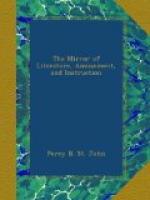Mrs. R. There are some facts, indeed, connected with this, which prove this origin beyond question, as you will admit, when I tell you that specimens of wood are often found partly converted into coal and partly unchanged, or petrified by some other mineral.
Edward. This will, at least, be direct proof that wood may be converted into coal.
Mrs. R. One instance of this kind is mentioned by Brand, in his “History of Newcastle,” as having been brought from Iceland, by Sir Joseph Banks. Dr. Rennie, in his “Essay on Peat Moss,” gives a still stronger example. In the parish of Kilsyth, he tells us, there was found, in a solid bed of sandstone, the trunk of a tree in an erect position, the indentations of the bark and marks of the branches being in many parts of it still obvious. It rose from a bed of coal below the sandstone, and the roots which reached the coal, as well as the bark for an inch thick round the trunk, were completely converted into coal, while the centre consisted of sandstone. This specimen I have myself seen in the parsonage garden of Kilsyth, and this description is most accurate. Sir George Mackenzie lately found a specimen precisely similar, in the face of a sandstone rock in Lothian, and I have seen numerous specimens of bamboos and reeds in the sandstone quarries of Glasgow, with the bark converted into coal, and the centre filled with sandstone.
Edward.—But would not this prove that sandstone, also, was derived from wood?
Mrs. R.—No: it would only prove that the centre had been destroyed and removed; for the sandstone is not chemically composed of vegetable substances, but the coal is.
Edward—Still, I cannot conceive by what process the conversion is effected.
Mrs. R. By a natural process, evidently; being a continuation of that which converts mosses and marshes into peat. Nay, it is supposed not to stop at the formation of coal, but, by a continuation of the causes, the coal becomes jet, and even amber. The eminent chemist, Fourcroy, in proof of this, mentions a specimen in which one end was wood, little changed, and the other pure jet; and Chaptal tells us, that at Montpellier there are dug up whole cart-loads of trees converted into jet, though the original forms are so perfectly preserved that he could often detect the species; and, among others, he mentions birch and walnut. What is even more remarkable, he found a wooden pail and a wooden shovel converted into pure jet.
Edward. Then I suppose, from all these details, that coal might be formed artificially, by imitating the natural process.
Mrs. R. Mr. Hatchett made many ingenious and successful experiments with this design, and Dr. Macculloch has more recently succeeded in actually making coal. One of the strongest instances of the process, is the existence of a great quantity of wood only half converted into coal, at Bovey, near Exeter; this has been much discussed by the geologists; but there is a bed of coal found at Locle, on the continent, which is said to have been formed almost within the memory of man, though I have not yet seen any good account of it.




